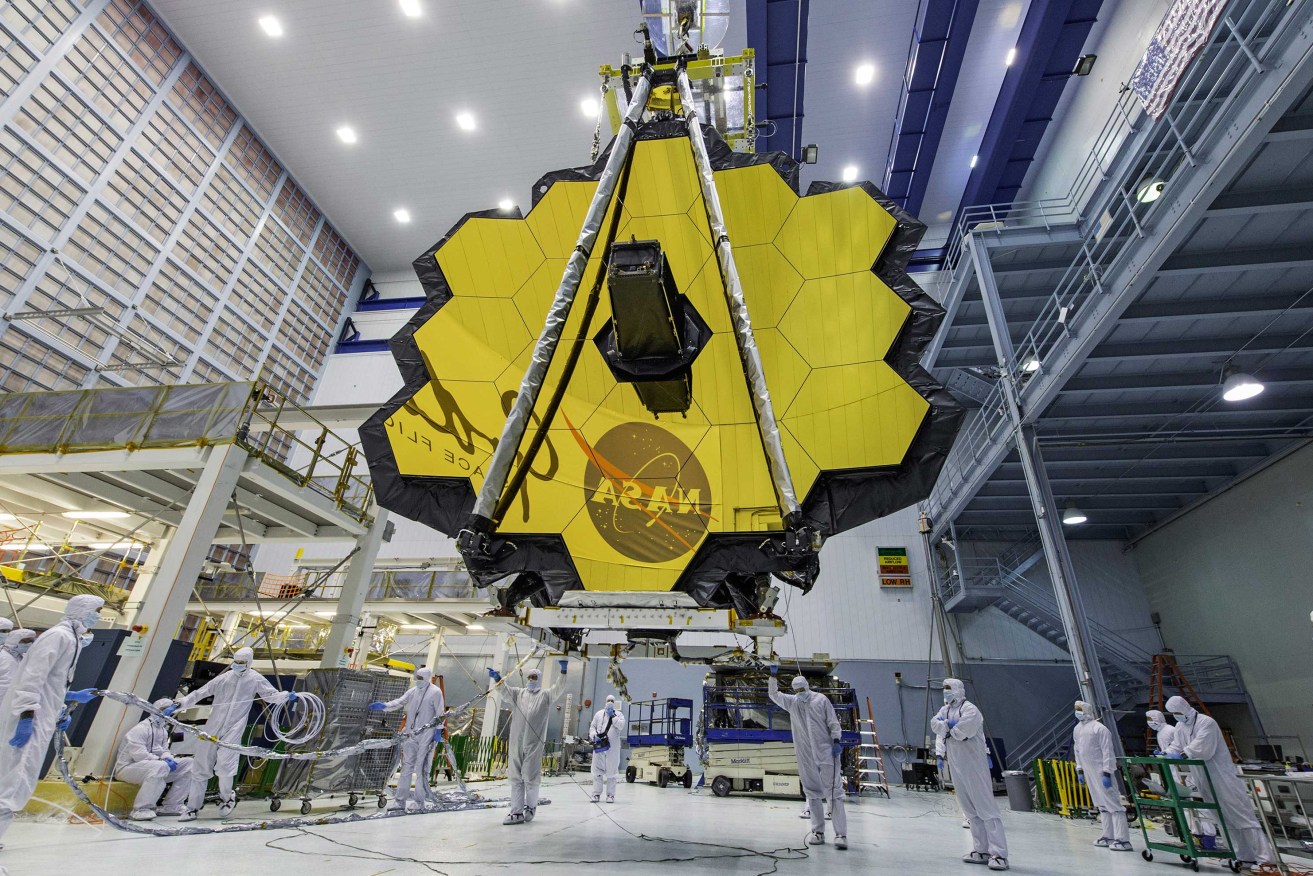NASA director in talks to develop internship program with SA
A top director at NASA will speak to Premier Steven Marshall about the potential to establish an internship program between the US space agency and South Australian universities.

Technicians working on the James Webb telescope at NASA's Goddard Space Flight Center in Greenbelt, Maryland. Photo: Laura Betz / AP
Deputy director of technology and research investments at NASA’s Goddard Space Flight Center, Dr Christyl Johnson, said she is in the process of establishing a working agreement between NASA and South Australia.
Johnson is responsible for charting NASA’s future research and will head to Adelaide next week to speak about emerging areas in space research at technology festival Hybrid World Adelaide.
She said the internship program would accept graduate scientists and some undergraduate engineering students to work at the Goddard Space Flight Center in Greenbelt, Maryland, for about a year.
“We have researchers that are already working with some of your researchers but to be able to have some of those students do an internship, coming over to the United States and spending maybe a year working in the laboratories, getting first-hand research experience with our researchers, that would be amazing,” Johnson told InDaily
“Our researchers would benefit and your researchers would benefit from that kind of exchange.”
Goddard Space Flight Center manages communications between mission control and orbiting astronauts aboard the International Space Station. It also houses a team of engineers tasked with building telescopes and operating test chambers that monitor orbiting satellites.
Johnson said she would meet with Marshall, State Government officials and Australian Space Agency director general Dr Megan Clark while she was in Australia to discuss opportunities for future collaboration.
She said on previous visits to South Australia she was impressed with the state’s communication technology industry and its “grassroots up” approach to space industry investment.
“Communication technology is something that you have been working on for quite some time now and I’ve also seen that you’ve been developing capability to actually build spacecraft,” Johnson said.
“You’ve got commercial companies that have been doing that and have actually delivered some spacecraft, which is wonderful, but many of the amazing things that I’ve seen is in your universities.”
Johnson said she was amazed at the investment in “state of the art” laboratory equipment at the University of South Australia, the University of Adelaide and Flinders University.
She said she was also impressed with Hamilton Secondary School’s Mike Roach Space Education Centre, established in September last year to encourage students to enter careers in the space industry.
“I don’t know of any students in a high school or middle school in the United States that get that kind of exposure – and that’s how you grab their attention and keep them.”
Johnson said while she wasn’t aware of South Australia’s economic capability to host Australia’s new space agency, she believed the state had the technical expertise to become a leading centre for space research.
Marshall met with Australian Space Agency head Megan Clark on Friday to spruik South Australia – and possibly the former Royal Adelaide Hospital site – as the best location for the national agency.
He said the agency could be set up in South Australia within six months.
The Federal Government pledged $41 million for the creation of an Australian space agency in the 2018-19 Budget, with the location of the agency to be determined by a bidding war between the states and territories.
A decision is expected to be reached by the end of the year.
“I can see that the investment is there to actually facilitate so many innovations right there in South Australia,” Johnson said.
“Your AI institute has been doing quite a few things at the University of South Australia, leading some research areas that could be very, very instrumental for all of Australia.
“Areas like quantum technology development is going to make a revolutionary change (which is about) being able to protect information going from one place to another without people being able to take your information or listen in on your conversations.”
Speaking on her own agency’s aspirations, Johnson said the Goddard Center was currently working on using its James Webb telescope to look back in time and “unravel the mysteries of the universe”.
The telescope will be the successor to the Hubble Space Telescope and will enable scientists to observe some of the most distant events and objects in the universe, including the formation of the first galaxies.
Johnson said scientists would also use the telescope to explore environmental changes on Mars.
“We want to use it to study what happened to Mars and what happened to other planets that could have had life-like existence, water and those types of things.”
“We need to understand that so that we can understand what could possibly happen to our own planet and do all that we can to prevent it.”
Johnson said humans could reach Mars as early as 2030.
“If we relied on the Government to do it alone, it would have to be in the 2030s that we would be able to finally see something starting to go up, but if private industry is engaged and private industry has the commitment there is the possibility that we could start to see this happening even earlier.
“It really just depends on how many people get committed and how well we can work together on a common goal.”
Dr Christyl Johnson will lead the Hybrid World Adelaide conference on space industry innovation and research from July 23 to 24. Find out more here.




